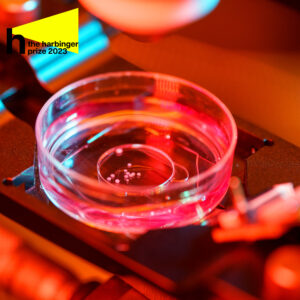17 year-old Inika Singh wins the Harbinger Prize in Science

Engineers at UC San Diego demonstrated for the first time that human brain organoids implanted in mice have established functional connectivity to the animals’ cortex.
October 13, 2023
Brains grown in a petri dish. On the potential of organoid intelligence
Growing brains in a lab seems like a plot straight out of a movie. Yet, seemingly defying reality, scientists grew 800,000 living brain cells in a petri dish.
These brain cells were able to complete a goal-oriented assignment of playing Pong, a 2D table tennis simulation. They also learned on their own, successfully performing tasks similar to the human brain.
A research team of Melbourne-based biotech start-up Cortical Labs grew mouse and human brain cells on microelectrode arrays. It is an electrode grid which can create an integrated network by stimulating and analyzing the cells. Feedback from its electrodes taught grown brain cells the paddle distance and how to hit the ball back and forth.
This ‘closed-loop environment’ creates a phenomenon known as organoid intelligence, where the cells interact, alter, and learn from each other outside of a living organism.
Power of biological learning
British mathematician Alan Turing stated: “A computer would deserve to be called intelligence if it could deceive a human into believing that it was human.” In 1950, Turing proposed the Turing test to determine if a machine can be said to be truly intelligent.
This is the premise of artificial intelligence: trying to achieve the same snap judgment and troubleshooting abilities as humans.
Computers were developed to speed up mathematical processes, as these machines are much better at computing basic information with sequential processing – processing information in a serial order.
Learn more:
How massive parallelism lifts the brain’s performance above that of AI
Human brains are far superior when processing more complicated information with uncertain data and challenging decision-making, as brains thrive in parallel processing.
For one, the brain consumes less power to fix issues. The world’s most powerful supercomputer, USA’s Frontier, consumes 21 megawatts of power as the standard measure of performance for a supercomputer, while the brain consumes only a fraction of watts at the same benchmark.
It is also easier to teach problem-solving by neurological means than by mechanical. A human only needed about 10 examples to learn a simple “same-versus-different” problem, while as recently as 2018 machines had trouble navigating these differences with 10 million samples.
Further limitations arise when machines are to solve problems that are constantly changing – organic intelligence is much better at adapting to variations.
Growing a computer
With newer developments in artificial intelligence, like Chat GPT (which is used for automation, data analysis, or even personal benefit), neurological researchers have had to ask an important question: If AI is based on our neurological systems, why can’t we process information better on the actual neurological system?
Organoid intelligence (OI) is a novel engineering and neurobiological field that uses a cell culture of human brain cells (organoids) to develop biological computers.
Organoids are created when clumps of brain cells are artificially placed together in a dish. They communicate through electrical and chemical signals – growing, learning, and organizing themselves.
While not exact replicas of miniature brains, these entities have a structural similarity that includes neurons, brain cells, and important mental processes like learning and memory. The three-dimensional structure of these cell cultures allows for more connections between neurons, or more room to learn.
There are a few key steps to produce an effective organoid. One is to ensure there are cells involved in human learning, like glial cells, which play an active role in memory and knowledge. This can boost memory formation and help the cell culture learn faster. Another is producing an enriching environment so cells can thrive with oxygen and other nutrients.
Finally, there must be a system to record and analyze data output from cell communication which gives scientists appropriate feedback on what the cells are thinking. These are where 3D microelectrode arrays arise, as they will be able to pulse and obtain signals. Additional testing must be completed to prevent structural or behavioral damage to the brain cells.
Organoids have been developed through stimulation, like by researchers at Cortical Labs. The brain cells receive feedback and teach themselves without scientists controlling them to complete brain-like functions.
Another way is through neuromorphic chips, connecting neurons within computer chips. Companies like IBM and Intel are trying to use this neural hardware integrated within artificial intelligence to increase energy consumption efficiency and speed when examining the stock market.
IBM’s chip known as TrueNorth has 1 million neurons with 256 million synapses that compute, connect, and remember information. A chief scientist for this chip at IBM, Dharmendra Modha, describes this as “literally a supercomputer the size of a postage stamp, light like a feather, and low power like a hearing aid.”
The millions of neurons speed up its processing, shown through recognizing objects such as cars, trucks, and pedestrians as fast as a human.
In addition, Dr. Hartung of John Hopkins Bloomberg School of Public Health in Baltimore and his team developed a “brain-computer interface device” where organoids submit and receive signals from electrodes. His goal was not only to advance AI but discard animal testing in medical diagnoses. Both ways use similar cell culture methods to nurture these neurons.
Together, these observations have created high expectations for brain-directed computing as an alternative to silicon-based computing.
The potential of OI unlocks unprecedented advances in computing speed, processing power, data efficiency, and storage capabilities - all with lower energy needs.
Organoid Intelligence
The human brain is the ultimate supercomputer. It has around 86 billion neurons with 1 quadrillion connections, which has a potential storage capacity of 2,500 terabytes. These potential super-biocomputers can store data more than imaginable with AI.
In 2016, it took 17 million kilowatts to power US-based data centers, whereas hypothetically human brains could do this with just 1,600 kilowatts of energy. The amount we can store on a tiny computer chip is becoming more limited even as technology advances, but because of the sheer number of neurons in the brain, storage is limitless.
This serves as an illustration of how efficient OI energy consumption could be, although the currently produced organoid is one 3-millionth the size of the human brain.
“They are too small, each containing about 50,000 cells. For OI, we would need to increase this number to 10 million,” Dr. Hartung explains.
A potential biocomputer would have a brain organoid with a microelectrode array so that scientists could send and receive information to the system. The organoid can be integrated with medical procedures like chemical perfusion, neurons in the brain, or other organoids such as retinal organoids for extensive research or treatment. The main interface can also be connected with AI and data organization programs for companies to streamline efficiency.
This is what organoid intelligence encompasses – a variety of tools connected to the organoid that can function like a brain.
OI has the ability to surpass AI in terms of speed, power, and efficiency, all while requiring less energy and more storage. The cells do not comprehend punishment or reward, but can infer and predict by themselves. The electrical activity in human brains triggers a synapse, or space between two neurons that transfers information. This stores possibly endless amounts of information in our brain, which is the storage organoids hope to reach.
Medical Innovations
Learn more:
Neuroscience breakthrough demonstrates ability of human organoids to adopt functions of host’s visual cortex
The brain and its neurodegenerative diseases are still under research. OI can unlock the mysteries behind cognitive maturation, neurological, and psychiatric disorders such as Alzheimer’s disease and dementia.
Along with stem cells, brain organoids can be produced from adult tissues, creating individually tailored brain organoids for these diseases.
Jens Schwamborn, professor of cellular and developmental biology at the University of Luxembourg is studying neurodegenerative diseases through organoids. This is important because animal model clinical trials of Alzheimer’s disease therapies are not usually successful due to differences in animal and human brains. OI allows for an ethical creation to properly treat life threatening diseases.
Organoid intelligence may also help us discover causes of unknown genetic conditions like autism and schizophrenia. Our knowledge of these neurodevelopmental disorders is severely limited, but the patients diagnosed are rapidly growing. Knowing the cause can aid in developing treatments and prevention for cognitive impairments.
Organoids of kidneys and lungs have been grown in labs and used to combat animal testing. Now that neuronal organoids have cognitive processes similar to humans such as memory, future research is limitless.
Ethical Boundaries
Organoids, 10 weeks after being created in cell cultures, have similar attributes to fetuses in the womb at 20 weeks. One has to wonder whether these organoids that are being manufactured are living and feel negative emotions such as pain.
The only way to determine that is through a more thorough examination into morally significant biological aspects that are like abilities like consciousness, as well as further studies on the fundamental differences between OI and human brains.
This technology is a new frontier, so as it improves, more ethical perspectives might need to be considered.
Future of OI
The possibilities of OI are vast and expanding, especially when combined with machine learning.
Creating a brain that can solve problems, systemize responses, interact with electrical devices, work with computers to streamline efficiency, and find treatments for neurological disorders could soon be a reality.
For now, brain cells are simply playing video games. By the time I turn fifty, these little brains might just be computing humanity to the stars.




